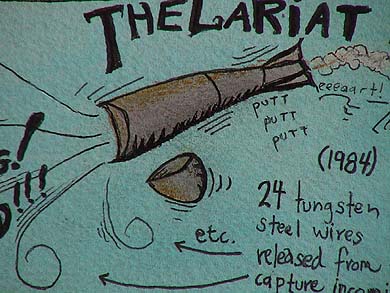
Listen
to voice over artist Tim George

read
the part of Hank Peabody
Visit
Tim George's website to learn more
about his work
www.timgeorgevo.com
The Lariat Missile
25.
Wherein an Experimental
Rocket
is Launched Over the Pacific
from Vandenberg Air Force Base
THE ROCKET WAS OF THE LARIAT SERIES and although it would soon be phased
out, the Lariat’s premise was simple enough with regards to anti-ballistic
missile defense.
A Lariat could be fired from any U.S. military installation
or submarine in the world. If enemy missiles were detected—fired
from their submarines or home turf—the Lariat, traveling in groups
of up to ten to twenty, would gallop into the atmosphere to meet incoming.
When directed, the Lariat’s nose would deploy twenty-one tungsten
steel wire lariats, each with a retractable noose designed to lasso
the fuselage of the incoming missiles.
The engines of the Lariat were massive and when enemy missiles
were caught in the wiring, they would be carried back to the launch
site. At the very least, enough wire would be spread about to confound
enemy trajectories, tangling the lot out of the sky and into the ocean.
Success or failure of the mission would be monitored by the transmitter
placed in the nose of the Lariat, sending directional information to
AWACS flying in the area.
Today’s launch aimed for the Kwajelein Atoll, South
Pacific, just on the other side of the International Date Line, well
within the Lariat’s 4800 mile range.
Kwajelein means “abundance of material and spiritual blessing.”
In the late 1940s, a handful of men traded their way onto the island
with glass beads, baseball gloves, outboard motors and the commemorative
notion of having just kicked the shit out of the Japanese.
On November 21, 1963, the last proa or local, traditional
boat was constructed. From then on the outboard was king and Little
America sat tight with its radios, radars, Halloween pregnancies and
Autumn bicycles for each of the many missile-types that over the years
came howling out of the sky to kerplunk in local waters.
Forty-five minutes after launch, the Lariat entered Kwajelein airspace
in its downward trajectory. It charged out of the atmosphere, tungsten
wires and nooses looped around a fair collection of flying vehicles
encountered during the arc of flight. The Lariat fell towards Kwajelein
with its booty: two dozen birds, three weather balloons, two commercial
airliners, one AWACS, Christmas ornaments, canned hams, and a white
beard. It hit the beach pinging once across the lagoon like a water
pale, scattering clip-boarded technicians.
On the other side of the lagoon, some of the locals were
tending to their boats.
“Touchdown,” said one, oiling his motor, checking
the throttle.
“That was something.”
“Amazing, huh?”
“Yeah, something amazing.”
“Next one we reach out and touch.”
|

